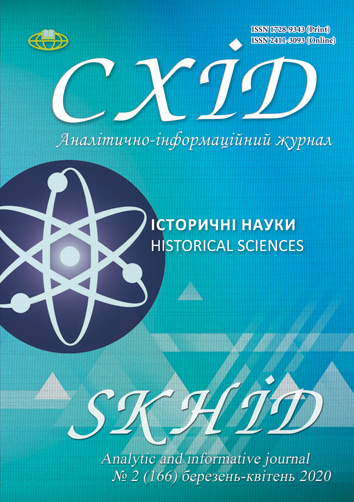Place of the United States Secretary of States in the power system and formation of the country external course (XX - at the beginning of XXI century): historical backgraund
DOI:
https://doi.org/10.21847/1728-9343.2020.2(166).201477Keywords:
US, Secretary of State, executive power, State Department, foreign policyAbstract
The article deals with the position of the head of the US Department of State - Secretary of State in the US government system and his role in shaping the country's foreign policy. The author emphasizes the lack of basic research on this topic and the availability of only factual material on the activities of the Secretaries of State in various historical periods of American history. It is noted that the Secretary of State's position is not quite similar to that of the Minister of Foreign Affairs, since he serves in this country in two roles: as the President's foreign policy chief adviser and as the head of a vast diplomatic corps. The author points out that the role and status of the Secretary of State is not regulated at the constitutional level and provides a list of powers of the Secretary of State and notes their extension since the creation of such office in 1789. The author points out that, before the Second World War, in most cases, in the tandem, the President-Secretary of State was the second to formulate the foreign policy of the country and to initiate its implementation, and was able to do justice to the president. Secretaries of State such as R. Lansing, B. Colby, and C. Hughes have enjoyed the trust of their presidents and have had a significant influence on the conduct of American foreign policy. During the presidency of F. Roosevelt and G. Truman, these individuals were themselves Secretaries of State, maximally moving the heads of the State Department to the background, giving them the opportunity to "bring order" not in the foreign policy arena, but in the State Department. It was not positive for the role of the Secretary of State and his Office the adoption of the 1947 Act establishing the National Security Council and the separation of a separate position - the President's national security adviser. From this very moment, the leaders of the National Security Council began to popularize the idea that foreign policy is not just one of the activities of the state, but directly a component of national security. Of course, this has led to increased NNG involvement in the country's foreign policy, which has often led to conflicts between the President's National Security Advisor and the Secretary of State, and the US President himself has not always supported the latter. It is noted that the Secretaries of State under Presidents J. Kennedy, L. Johnson, and R. Nixon, J. Bush Jr. played a rather indirect role in the country's foreign exchange. In contrast, Presidents D. Eisenhower, R. Reagan, B. Clinton and B. Obama respected and acted in tandem with their secretaries of state.Downloads
References
Biographies of the Secretaries of State: Charles Evans Hughes (1862-1948). Retrieved from: https://history.state.gov/departmenthistory/people/hughes-charles-evans.
Biographies of the Secretaries of State: Cyrus Roberts Vance (1917-2002). Retrieved from: https://history.state.gov/departmenthistory/people/vance-cyrus-roberts.
Biographies of the Secretaries of State: Henry A. (Heinz Alfred) Kissinger (1923-). Retrieved from: https://history.state.gov/departmenthistory/people/kissinger-henry-a.
Biographies of the Secretaries of State: Robert Lansing (1864-1928). Retrieved from: https://history.state.gov/departmenthistory/people/lansing-robert.
Campbell, J. F. (1971). The Foreign Affairs Fudge Factory. N.Y.: Basic Books, Inc. Publishers.
Chetverikov, S. B. (1974). Who and how does US policy. Moscow: International Relations (In Russian).
Clinton, H. R. (2014). Hard Choices: A Memoir. New-York: Simon & Schuster.
Estes, T., Lightner, E. (1976). The Department of States. N.Y.
Ivanyan, E. A. (1975). The White House: presidents and policy. Moscow: Political literature press. 347 p. (In Russian).
Kengor, P. (2000). The Vice President, Secretary of State, and Foreign Policy. Political Science Quarterly, 115(2), 175-199. DOI: https://doi.org/10.2307/2657899.
Lobanov, S. I. (1982). “Foggy bottom” today in USA. Economy, Politics, Ideology, 7, 117-123 (In Russian).
McCoy, D. R. (1982). The Presidency of Harry S. Truman. Lawrence: University Press of Kansas.
Philpott, Don (2015). Understanding the Department of State. Bernan Press.
The Constitution of the United States. Retrieved from: https://constitutionus.com/.
Walker, R. (1965). The American Secretaries of State and their diplomacy. New York: Cooper Square Publishers.
Willian, S. (2010). White. Majesty and Mischief. N.Y.: Kessinger Publishing, LLC.
Yilson, D. (1995). American government. Moscow: Publishing group Progress. 512 p. (In Russian).
Yunglyud, V. (1996). The last Secretary of State of the Franklin Roosevelt era in USA. Economy, Politics, Ideology, 9, 75-85 (In Russian).
Downloads
Published
How to Cite
Issue
Section
License
Copyright (c) 2020 Tetiana Klynina

This work is licensed under a Creative Commons Attribution-NonCommercial-NoDerivatives 4.0 International License.
1. Authors bear responsibility for the accuracy of facts, quotations, numbers and names used.
2. Manuscripts are not sent back.
3. The publisher does not always agree with the authors' opinion.
4. The authors reserve the right to authorship of the work and pass the first publication right of this work to the journal under the terms of a Creative Commons Attribution-NonCommercial-NoDerivatives 4.0 International License. This license allows others to distribute (copy) the published work for non-commercial purposes, provided there is mandatory attribution to its authors and a link to the first publication in our journal.
5. The authors have the right to conclude separate supplement agreements that relate to non-exclusive work distribution in the form in which it has been published by the journal (for example, to upload the work to the online storage of the journal or publish it as part of a monograph), provided that the reference to the first publication of the work in this journal is included.

